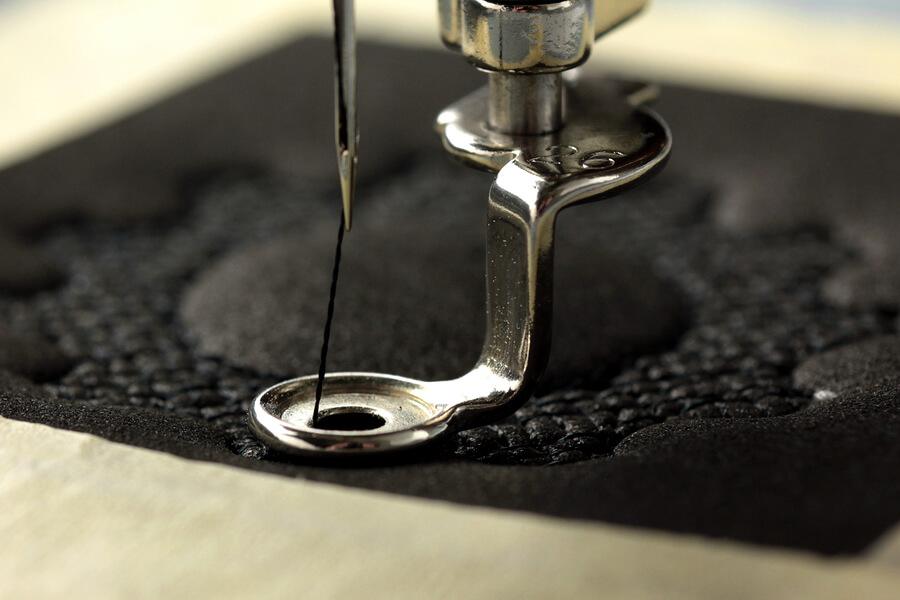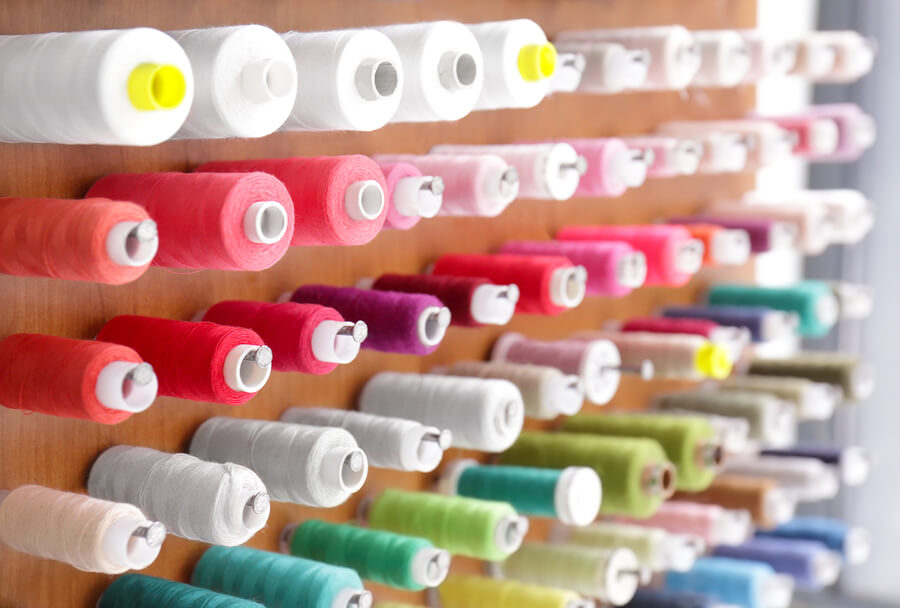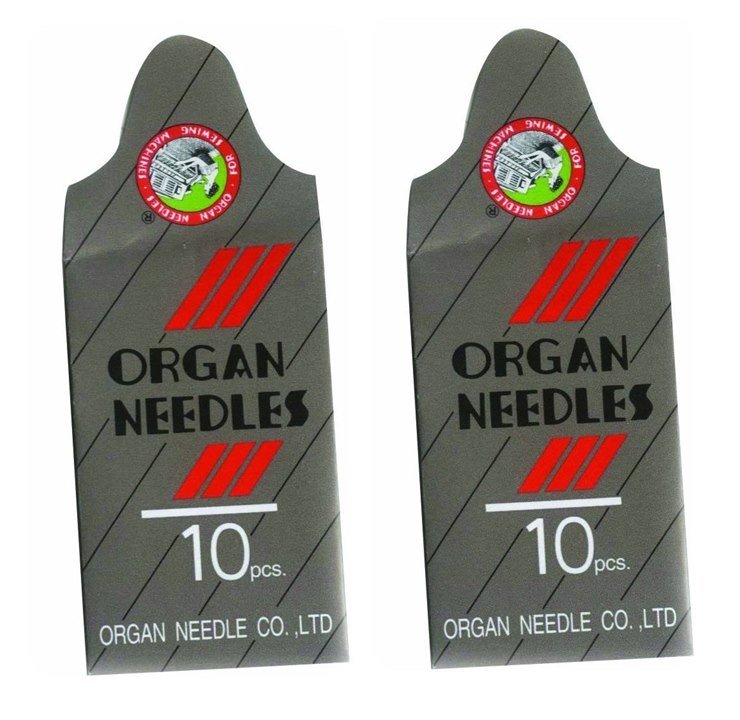Types of Thread and Needles Used for Machine Embroidery
Sometimes even experienced embroiderers underestimate the importance of choosing the right needle and thread. Not only do these two factors play an integral role in the outcome of the embroidery, but the right combination will make the process go a lot smoother along the way. With so many types of thread and needles to choose from, making the right choice can be overwhelming. Needles come in a variety of types and sizes and each works best with a certain type of thread. The key to making the right choice in needle and thread starts with the type of fabric being embroidered. Once you understand the different options in needles and thread and how they work together to embroider, you should be able to choose the best combination for any project.

The Parts of the Needle
The uppermost part of the needle is the thickest and it is called the “shank.” Embroidery machine needles have a shank that is rounded in the front and flat in the back. This design lets you place the needle into the machine easily in the correct direction.
The point of the needle is the part that comes into contact with the embroidery fabric first. The point makes an opening in the fabric, either by piercing it or going between the threads, carrying the thread to the back of the fabric.
The long part of the needle between the point and the shank is the shaft. The shaft is smaller than the shank and larger than the point. The eye is the opening in the needle near the point. The thread is channeled through the eye so that the needle carries it through the fabric to make a stitch. There is also a visible groove at the bottom of the eye that is positioned to the front when inserted which directs the thread through the needle.
There is an indentation on the back of the needle opposite of the groove called the scarf. When the needle is on the bottom of the fabric, the scarf allows the bobbin casing to come near enough to the eye to catch the thread and make a stitch.
Standard Embroidery Needles
Standard embroidery needles are made for use with polyester and rayon embroidery threads on virtually any type of fabric. The size of embroidery needles are listed in a double number format such as 75/11. The first number represents the European metric system in millimeters and the second one is the American number system. (If you are purchasing twin or triple needles, the first number represents the distance between the needles and the second number is the European needle size.) The 75/11 needle is the standard sized needle and usually what is included with a new embroidery machine. Needles numbered lower than 11 are finer and those numbered higher are thicker.
Getting to the Point
Normally, sharp needles are used on woven fabrics while ballpoint needles are used to embroider knits or delicate fabrics. When embroidering on fabrics that tend to “fuzz up” or get runs or tears, it may be due to the sharp point of the needle. Try switching to a ball point needle to get cleaner results. Some types of fabrics may not respond as well to sharp needles as others.
Over time, and with practice, embroiderers usually find the size and type of needles that they prefer even if they are not typically what is recommended. When you are not getting the results you expect on a project, you may want to change your needle size or just change to a fresh needle to try and get better results.
Why Needle Size Matters
Once you have chosen your embroidery fabric, the next step is to choose the best size and type of needle. The way the fabric is woven will determine how big the needle should be and how large the hole should be that the needle makes when stitching.
There are also specialty needles that are used with certain types of fabrics and threads. For example, if you are embroidering with extra thick thread such as heavy wool, then a thick thread needle will have an even larger eye to accommodate the threads bulky size. Specialty needles for use on leather have a wedged point that will leave a smaller hole in the fabric. Other types of specialty needles include hemstitch needles with create open decorative stitches and twin needles used for topstitching.
While embroidery pros don’t always agree on technique, most do agree that you should change needles regularly. If a needle begins to get bent, replace it to prevent breakage. Having the right needle won’t matter if it is not in good shape.
Embroidery Machine Thread

Although needle size increases as the number gets higher, embroidery thread is exactly the opposite. A higher number weight is actually a lighter weight thread while decreasing numbers are heavier. That means that a 30-weight embroidery thread is heavier than the standard 40-weight thread.
Embroidery thread comes in a variety of materials including:
· Silk
· Clear
Rayon has long been a favorite for its easy accessibility and wide array of color choices. The biggest problem with rayon is that the colors tend to fade over time. Today, polyester embroidery thread is quickly taking the place of rayon as a favorite choice because it is strong, has a similar appearance and shine to that of rayon, and it also resists fading. Polyester threads are made from multiple filaments to create a trilobal pattern that catches light and makes embroidery shinier.
Cotton thread is often used in traditional or heirloom embroidery where a matte finish is desired. Machine embroidery using cotton thread looks more like hand embroidery making it ideal for quilting some some designs.
Specialty Threads
There are numerous types of threads on the market that are used for special types of projects. Of these, metallics are very popular in spite of the difficulty many people have in using them. The thread is made by wrapping holographic fibers around a core. Round thread tends to work best and a larger topstitch needle can help. Some experts also recommend lowering the machine tension when working with metallic threads.
Light sensitive thread that appears white in normal lighting and glows in the dark is ideal for creating holiday items, especially for kids. Clear thread is used when you don’t want embroidery stitches to show on the top of the fabric, such as with applique.
The choice in embroidery thread is based primarily on the appearance you want for your final project but the fabric choice matters here, too. The fabric should be capable of handling the thread weight for the pattern. Using a heavy weight thread for a dense embroidery pattern on a piece of lightweight fabric isn’t going to turn out well. Think of balancing out the weight between the fabric, needle, and the thread you use for the design you are creating.
Different thread content will determine whether the design is shiny, vibrant, or matte and subdued for an old-fashioned look. Even more important that the thread material is the quality. Always use good quality thread that is compatible with your embroidery machine.
Bringing It All Together
| FABRIC WEIGHT | EXAMPLES | THREAD TYPE & SIZE | NEEDLE TYPE & SIZE |
| Lightweight/Thin | Georgette, Satin, Linen, Lace*, Chiffon | Cotton or Synthetic** 60-90 Silk 50 | Sharp 65/9 to 75-11 |
| Medium | Cotton Broadcloth, Velvet, Gabardine, Flannel, Taffeta | Cotton or Synthetic 60-90 Silk 50 | Sharp 75-11 to 90-14 |
| Heavy/Thick | Denim, Upholstery Fabric, Brocade, Poplin, Canvas | Cotton 30 or 50 Synthetic or Silk 50-60 | Sharp 100/16 Sharp 90/14 to 100/16 |
| Stretchy Knits | Jersey, Lycra, Tricot | Specialty Thread for Knits 50-60 | Ball Point 75/11 to 90/14 |
| Sheer Fabrics that Fray Easily | Gauze, Georgette, Batiste | Cotton or Synthetic 50-90 Silk 50 | Sharp 65/9-90/14 |
| Topstitching | Any | Synthetic 30 Silk 50-60 | 100/16 75/11 to 90/14 |
| Bobbin Thread | Any | Special Bobbin Thread in Various Weights to Match the Machine Thread Weight and Fiber Content |
*Some sewers prefer to use a sharp needle to sew lace but other recommend a ballpoint for working on the intricate patterns. Be certain to use stabilizer underneath so that the needle and thread has a solid canvas for the embroidery. This material also makes it easier to use a sharp needle in spite of open lace designs.
**Synthetic may be either polyester or rayon thread.
Any type of fabric not included in the chart will fall in the category of “specialty fabrics” and will require the specialized threads and needles made specifically for these types of fabrics. Although you will probably run across some problems along the way, making careful choices in the fabric, thread, and needles you use for each project will help eliminate your need for troubleshooting and make you a more successful embroiderer!


